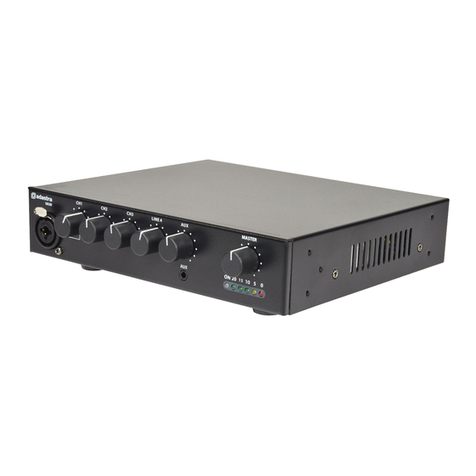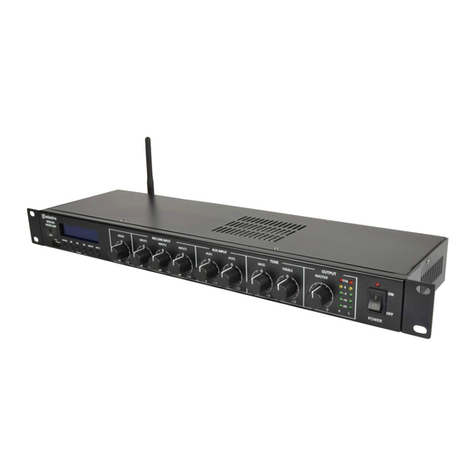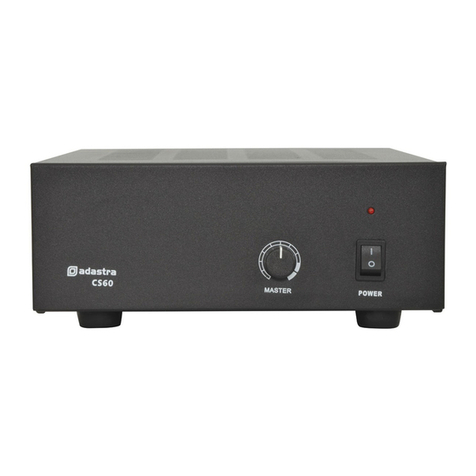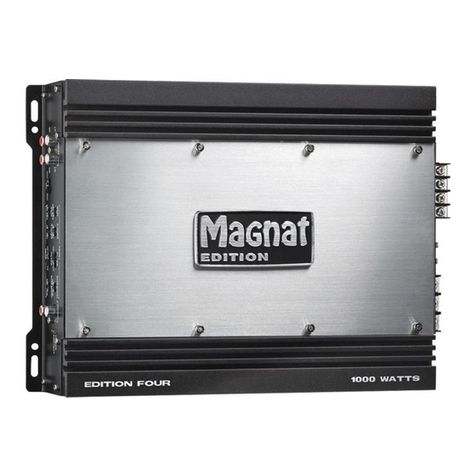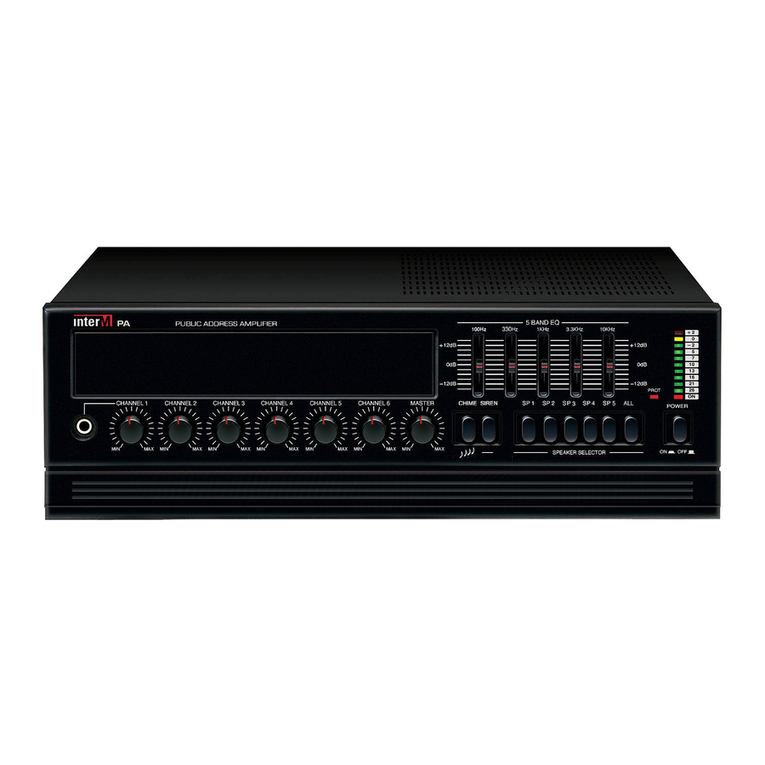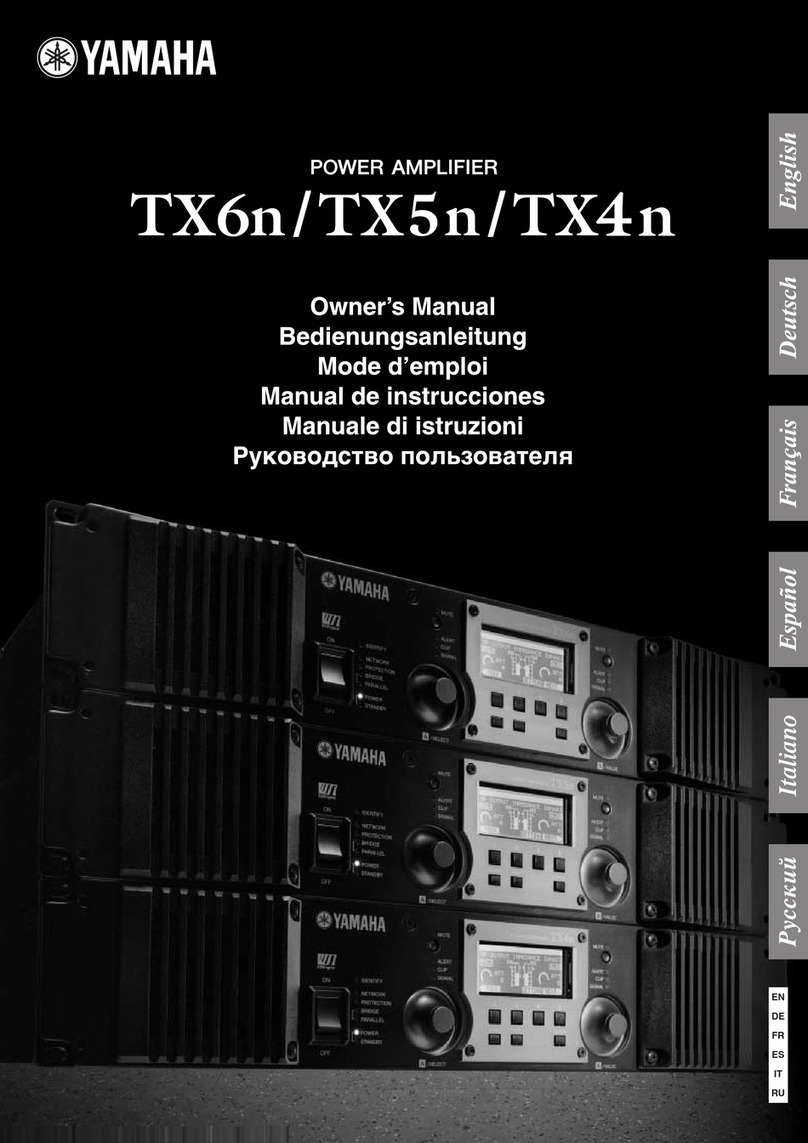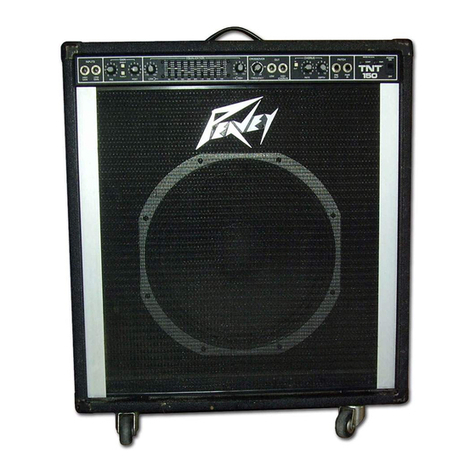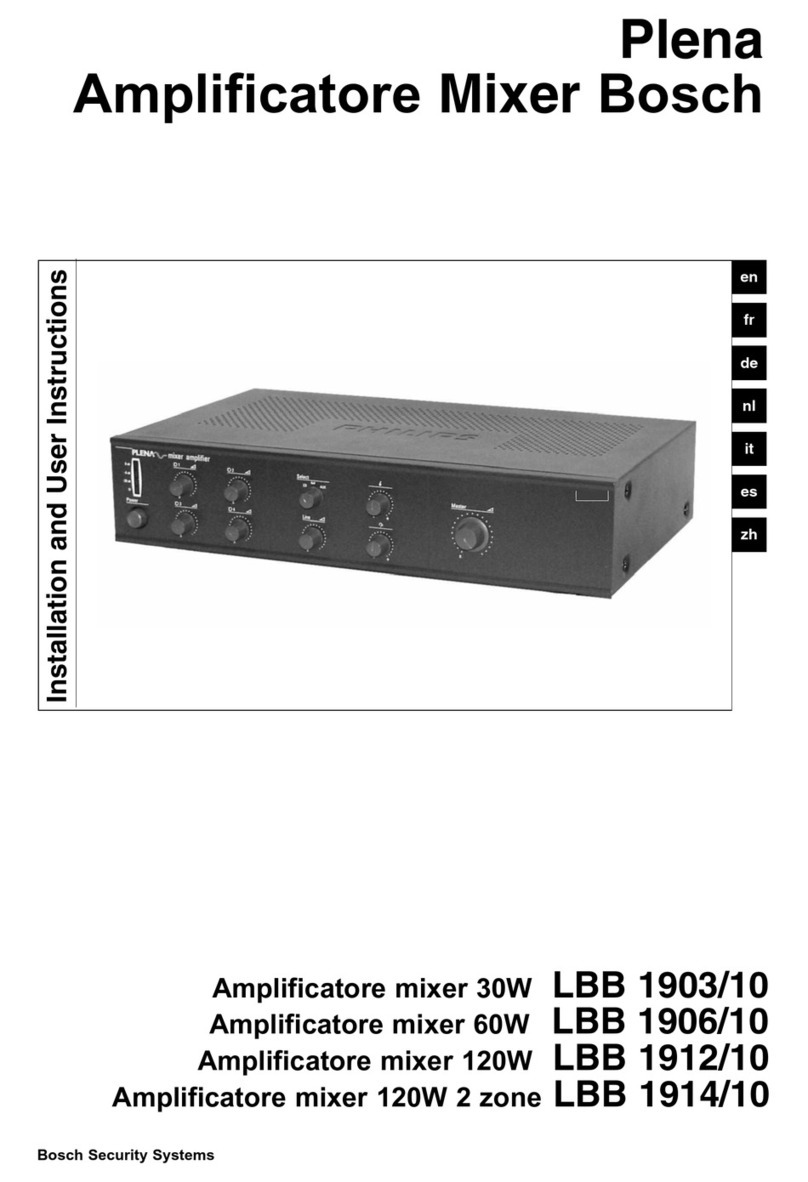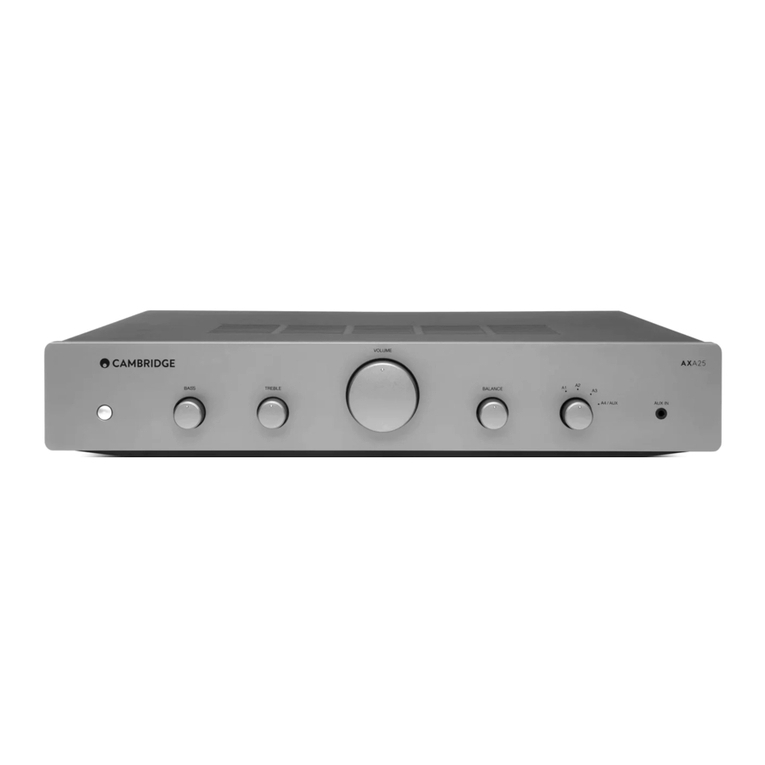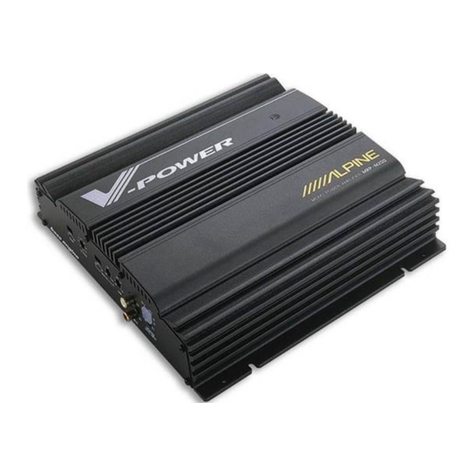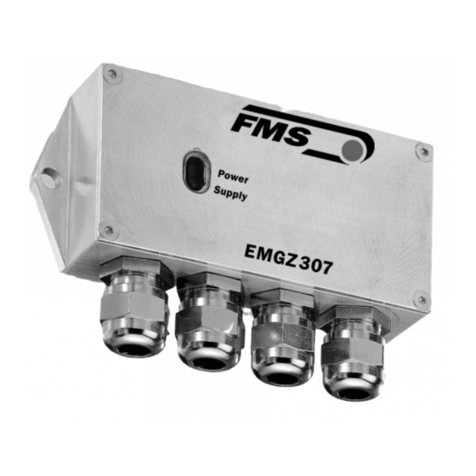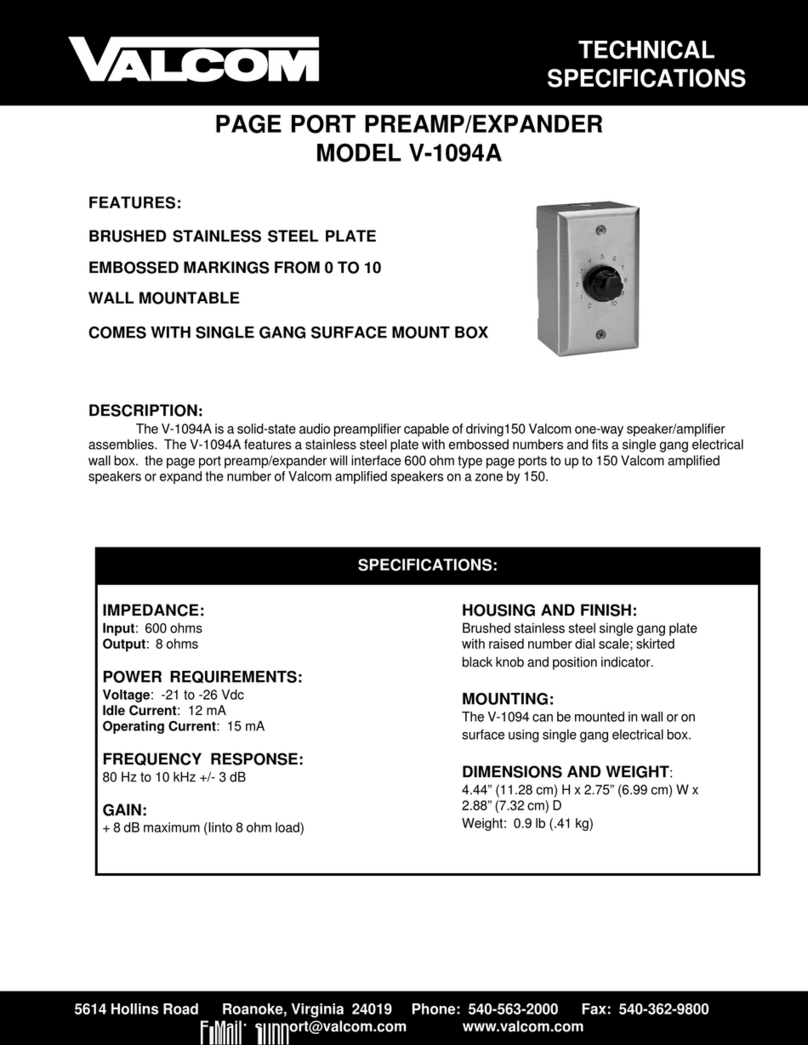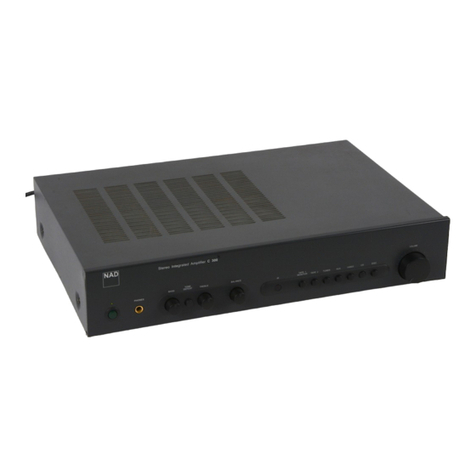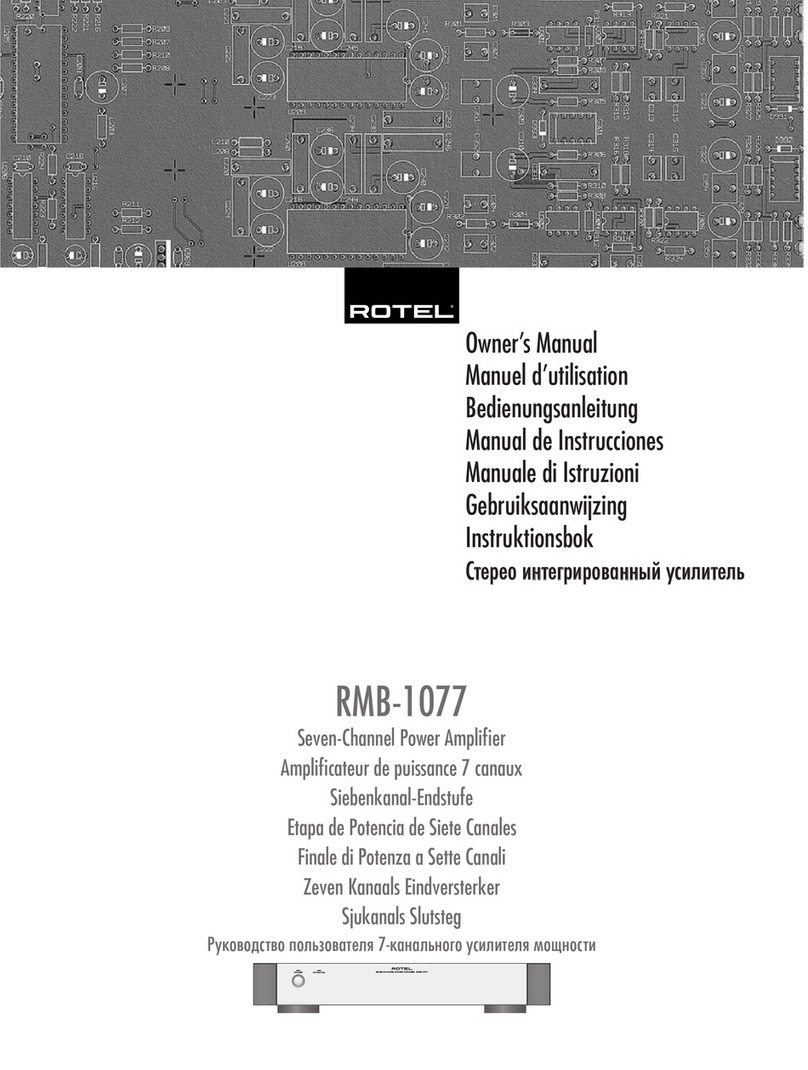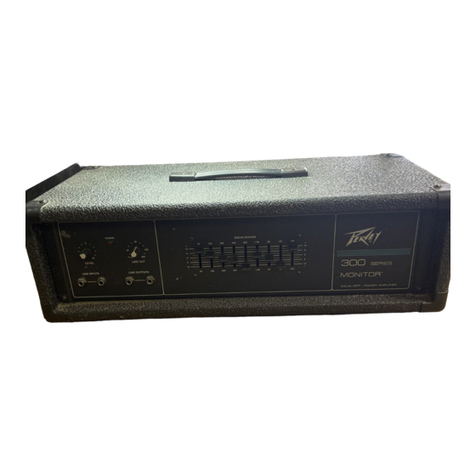Adastra LA 300 User manual

Operation Manual
Models:
LA 600
LA 300
Loop Amplifier
CH-1 CH-2 CH-3 BASS TREBLE LOOP CURRENT SIREN
POWER
PEAK CURRENT
123 4 567ON
INPUTS
LA Series
LOOP AMPLIFIER LA-300

2
IMPORTANT
Then wires in the mains lead are coloured in accordance with the
following code:
Green & Yellow: Earth (E)
Blue: Neutral (N)
Brown: Live (L)
As the colours of the wires in the mains lead of this apparatus may not
correspond with the coloured markings identifying the terminals in your
plug proceed as follows:
The wire which is coloured green and yellow must be connected to the
terminal which is marked by the letter E or by the safety earth symbol or
coloured green and yellow. The wire which is coloured blue must be
connected to the terminal which is marked with the letter N or coloured
black. The wire which is coloured brown must be connected to the terminal
which is marked with the letter L or coloured Red. If a 13Amp (BS1363)
plug or any other type of plug is used, a 5 Amp fuse must be fitted either in
the plug or at the distribution board.
WARNING: THIS APPLIANCE MUST BE EARTHED
OPERATION MANUAL - LOOP AMPLIFIERS
WARNING: SHOCK HAZARD - DO NOT OPEN
AVIS: RISQUE DE CHOC ELECTRIQUE - NE PAS OUVRIR
C A U T I O N
RISK O F ELECTRIC SHOCK
DO N O T O P EN
Front Panel (LA 300)
Front Panel (LA 600)
Front Panel (La 600)
Rear Panel (LA 300)
Rear Panel (LA 600)
CH-1 CH-2 CH-3 BASS TREBLE LOOP CURRENT SIREN
POWER
PEAK CURRENT
123 4 567ON
INPUTS
OFF
LINE
PHANTOM
MIC
L
R
- 3
+2 11
CH-3
OFF
LINE
PHANTOM
MIC
L
R
- 3
+2 11
CH-2
OFF
LINE
PHANTOM
MIC
L
R
- 3
+2 11
CH-1
3.0
2.5
2.0
1.5
1.0
0.5
0
dB / Octave
METALLOSS
CORRECTION
SLAVE
I/O
SLAVE
I/O
LOOP OUTPUT ALARM INPUT
LOAD IMPEDENCE : 0.2W MIN / 2.0W MAX.
LOAD IMPEDENCE : 0.2W MIN / 2.0W MAX.
230V ~ 50Hz
FUSE T1A/250V
100VA
FUSE
12
3
12
3
12
3
If the unit is to be put out of operation
definitively, take it to a local recycling
plant for a disposal which is not harmful
to the environment.
1. Controls for adjusting the preamplification
1 Operating Elements & Connections
for the mono channels CH1 to CH3
2. Tone controls
BASS = Bass control
TREBLE = Treble control
3. Control LOOP CURRENT for adjusting
loop current.
4. LED siren : lights up when siren signal
5. Level indication for the loop current.
6. POWER LED
7. POWER switch
8. Support for the mains fuse :
9. Mains jack for connection to a socket
10.Clamping screw for a possible ground
11. Screw terminals for connection of the
12. Screw terminals for an external momen-
connection
Inductive loop.
tary Push button (closing contact) or
switch for triggering an alarm siren. The
siren sound as long as button is pressed.
(230V ~ / 50Hz) via the supplied mains
cable.
Only replace a blown fuse by one of the
same type.
sounds.
01
01
08
08
09
09
10
10
11
11
12
12
1718
1718
02
02
03
03
04
04
05
05
06 07
07 06
13 14 15 16
13 14 15 16
13 Input jacks (combined XLR/6.3 mm
Jacks, bal.) channels 1 to 3 for conne-
ction of microphones or Mono units
with line level ; the connection of each
signal source is alternatively possible via
an XLR or a 6.3 mm plug
14 DIP switch PHANTOM POWER for swit-
ching the phantom voltage to the XLR
connections of the jacks INPUT; required
when connecting capacitor or electret
microphones operating with phantom
power.
15 DIP switch for INPUT SENSITIVITY
Selector
switch position MIC: microphone level
switch position LINE: line level
LOOP AMPLIFIER LA-300

16 RCA phono INPUT 1 to 3 for units with line output (e. g. CD player, cassette recorder, etc.); the signals of the stereo channels L and
R are internally mixed to a mono signal
17
18
Control METAL LOSS CORRECTION
Jack SLAVE I/O for connection of another loop amplifier.
Connections at the plug :- tip = output , ring = input , body = ground
(only active if the jumper J8 is placed to the ON position)
2 Safety Notes
This unit corresponds to all required directives of the EU and is therefore marked with
It is essential to observe the following items:
The unit is suitable for indoor use only. Protect it against dripping water and splash water, high air humidity, and heat (admissible
ambient temperature range 0 – 40 °C).
Do not place any vessels filled with liquid, e. g. drinking glasses, on the unit. The heat being generated in the unit must be car-
ried off by air circulation. Therefore, the air vents at the housing must not be covered.
Do not set the unit into operation, or immediately disconnect the mains plug from the mains socket if
1. there is visible damage to the unit or to the mains cable,
2. a defect might have occurred after a drop or similar accident,
3. malfunctions occur.
The unit must be repaired by skilled personnel.
Never pull the mains cable to disconnect the mains plug from the mains socket, always seize the plug!
For cleaning only use a dry, soft cloth, by no means chemicals or water.
No guarantee claims for the unit and no liability for any resulting personal damage or material damage will be accepted
if the unit is used for other purposes than originally intended, if it is not correctly connected, operated, or not repaired in an
expert way.
WARNING :- The unit is supplied with hazardous mains voltage (230 V~). Leave servicing to skilled personnel only and do not in-
sert anything through the air vents! This may cause an electric shock hazard. Only make or change all connections with the
sound reproduction system switched off.
3 Applications
4 Installation
The LA-300/600 are the active loop amplifiers in constant
1. Install the loop.
2. Before connecting a loop to the amplifier use a multimeter to check the loop is not shorted to ground at any point, ( it will
6. Connect music or speech input signal to the amplifier. The peak line level of this signal should be approximately 1V.Ensure
7. Increase the input levels controls until the ‘limit’ led is just flashing.This indicates that the dynamic range processor is
8. Adjust the drive control until the required current peak is produced. Care should be taken when doing this to ensure the
9. Using an induction loop receiver listen to the signal inside the loop. It is advisable to check the system with a field strength
meter. Please note that the orientation of the field strength meter may influence the reading.
current is within the recommended rating of the cable. The average current output should be approximately one quarter of the
maximum peak.
receiving a signal of the correct level. If you are usings both inputs the level controls acts as a simple mixer.
level controls and drive control are fully anticlockwise.
almost certainly damage the amplifier if it is).
current technique with dynamic compressor for creating an indu-
ctive sound reproduction system. It allows transmission of audio signals to hearing aids with a “telephone coil” and to inductive
receivers.
The wireless transmission is an advantage of inductive sound reproduction systems. Thus, the user is able to move
freely within the loop.
Inductive sound reproduction systems are used for various applications, e. g. as an aid for persons hard of hearing in churches,
theatres, cinemas, waiting rooms, meeting rooms, as interpreting installation
,for lectures in museums, exhibitions, etc.
In inductive sound reproduction systems, an induction loop is triggered with a constant current amplifier. An induction
loop consists of a wire winding laid into the floor, into the wall, or into the ceiling. Within this loop, a magnetic field is generated
which will induce a voltage in the induction receiver. The receiver will reconvert this voltage into an audio signal.Any number of
receivers can be operated within an induction loop.
The maximum size (600 m for LA 600 & 300m for LA300)
2 2 of an induction loop may be reduced due to field strength losses
which are caused by metal in ceilings and floors. Small losses
can be compensated with the function METAL LOSS CORRECTION.
The LA-300/600 has three channels to which units with a line output (e. g. CD player, tape deck, tuner) and microphones
phantom-powered) may be connected. The channel INPUT 1 is equipped with a talkover function which attenuates the volumes of the
other two channels by approx. 40 dB in case of an announcement. The loop amplifier may be used as a mixing amplifier or be
integrated into a PA system.
GB
3. Prior to installing the sound reproduction system check for any magnetic interference at the place provided for it. This may
impair the operation or even make the operation impossible. Interference is caused e. g. by transformers,high power
cables, fluorescent lamps with a standard choke, and data cables.
4. Besides magnetic noise fields, interference in inductive sound reproduction system may also occur due to reinforced concrete
floors or floor heating with copper cables. In this case, too, the magnetic field does not spread equally and in the extreme case
the use of an inductive sound reproduction system is not possible. If the interference caused by the reinforced concrete is
not too extensive, the frequency response may be adapted accordingly by means of the function METAL LOSS
CORRECTION.
5. When laying the induction loop in tubes, these must be made of plastic as metal tubes may strongly impair the magnetic
field of the loop.
3

Induction loop
The LA-600 allows to realize inductive sound reproduction systems for an area of up to 600 m (300 m for LA 300)
22
The of the sound reproduction
loop is laid at the edge area. The distance to the ear level should be approx. 1 m. It should
be avoided to lay the loop at different heights. A basic cable serves as an induction loop.
If the local conditions do not allow to lay the loop as an rectangle, a special loop design is required
calculated by an expert.
which must be
After the dimensions of the induction loop have been defined, calculate the cross section of the
loop current:
cable and the required
Cable cross section
The resistance of the loop must be in a range between 0.2 and 2W. After the length of the loop has
cable cross section.
been measured, determine
The required cross section for the defined cable length can be taken from figs. 1 and 2:
Fig. 1 Required cable cross section for the induction loop Fig. 2 Minimum and maximum loop lengths at certain cable cross section.
For the calculation of the loop resistance (R) [material: copper] also the following formula may be used:
l l x mm2
R = x cu = x 0.01786
A A m
A = cable cross section in mm2
l = loop length in m
cu = specific resistance of copper
0.01786 x mm2/m
W
W
Loop current
The value of the loop current depends on the size and the width-length ratio of the loop. With these
current can be taken from fig.3
values the required loop
0.25 0.5 0.75 1.0 1.25 1.5 1.75 2.0 2.25 2.5 2.75 3.0
25
50
75
100
2
cable cross section [mm ]
cable length [m]
m
in. loop resistance0.2 W
m. loo ress ta e2
ax p i nc W
admissible range Cable cross section in mm2
Loop length min. at 0.2W
max. at 2.0W
6 m
56 m
9 m
84 m
12 m
110 m
17 m
168 m
28 m
280 m
0.5 0.75 1.0 1.5 2.5
Fig. 3 Peak current in the induction loop
Example
loop width A = 10 m
loop length B = 20 m
loop width 10 m
width-length ratio = = = 0.5
loop length 20 m
With a loop width of 10 m and a width-length ratio of 0.5, a peak current of 4.9 A results in the loop.
Connection of the induction loop
The loop amplifier must be outside the loop
1) Twist the cable section between the amplifier and the loop.
2) Before the induction loop is connected to the amplifier, check with an ohmmeter to ensure that the loop is not earthed.
3) Connect the cable ends of the loop to the terminals LOOP OUTPUT (11)
Microphones
Up to three microphones may be connected to the combined XLR/6.3 mm jacks CH 1 to CH 3 (13). For CH1 the microph-
one ( 13) priority circuit may be activated
1) When connecting a microphone, set the corresponding DIP switch INPUT SENSITIVITY (15) to position MIC.
2) When using phantom-powered microphones, switch on the phantom power with the DIP
[position ON].
switch PHANTOM (14)
6
8
loop width [m]
peak current [A]
8 10 12 14 16 184
7
6
5
4
3
width-length ratio
2
0.25 0.5
0.75
1.0
1
CAUTION
NOTE
If the phantom power is connected, no micro
It is recommended to use electret condenser microphones for loop systems. Dynamic microphones may cause feedback
and distortion.
phone with unbalanced output must be connected to the corresponding input jack
(13), as the microphone may be damaged.
4
Units with line level
Up to three audio units with line output (e. g. CD player, cassette recorder) may be connected to the combined XLR/6.3 mm
jacks (13) or to the phono jacks (16) of the channels INPUT 1 to INPUT 3.

1) When connecting a unit with line output, set the corresponding DIP switch INPUT SENSITIVITY (15) to position LINE.
2) Set the corresponding DIP switch PHANTOM (14) to position OFF, otherwise the connected unit may be damaged.
Alarm siren
The internal siren may be activated via a switch or momentary pushbutton connected to the terminals
While the siren sounds, the
ALARM INPUT (12).
LED SIREN (4) lights up and the volumes of all other audio signals are automatically attenuated.
Application as a loop amplifier in a PA system
1) Feed the audio signal from the PA system to one of the jacks INPUT 1 to INPUT 3 (13). The signal should be balanced,
have line level (0.2 –1 V), and be independent of the volume control of the PA amplifier.
2) Set the corresponding DIP switch INPUT SENSITIVITY (15) to position LINE.
3) Set the corresponding DIP switch PHANTOM (14) to position OFF, otherwise the connected unit may be damaged.
5 Operation
First setting into operation
Operation with two loop amplifiers.
1) Prior to switching on, turn the controls INPUT 1 to
If one loop amplifier is not sufficient to supply the entire area, two loops may be installed which are driven by one ‘LA 600 or LA 300’
each. In this case one amplifier operates as a master (to which all signal sources are connected) and the second as a slave. Feed the
audio signal from the masteramplifier to the slave amplifier.
1) Connect the adaptor 6.3 mm stereo jack / 2 x phono in line jack to the jack ‘SLAVE I/O (18) of the master unit . The output signal to
2) By the connection of the jack SLAVE I/O, the signal way in the master amplifier between the mixing part and the power amplifier
3) From the ‘Y’ cable feed the output signal via an adaptor cable 2 x phono/6.3 mm stereo jack to the jack SLAVE I/O of the slave
amplifier. The signal must be present at the ring of the 6.3 mm stereo plug. Therefore, connect the red phono plug of the cable
to the ‘Y’ cable.
part is opened up. Therefore, this signal way must be closed again with a ‘Y’ cable.
be fed to the second loop amplifier is present at the tip of the 6.3 mm plug.
3 (1) and LOOP CURRENT (3) to the left stop.
2) Feed a signal (test signal, music piece, or microphone announcement) to all connected inputs.
3) Switch on the amplifier with the switch POWER(7). After switching on, the red LED (6) above the switch lights up.
4) Slightly turn up the control LOOP CURRENT (3) so that a signal can be received in the loop.
5) Control the level of the channels to be heard with the corresponding controls INPUT (1) and check the field strength in the loop
with a field strength meter. According to the European standard EN 60118-4 a field strength of 100 mA/m is recomme-
nded, and the maximum field strength should not exceed 400 mA/m. Both values are related to the reference frequency
of 1000 Hz.Adjust the field strength with the control LOOP CURRENT (3) accordingly. The 5-step LED row
output current. If no field strength
(5) shows the
meter is available, the adjustments can be checked with an induction receiver
for audio quality and receiving quality.
6) Adjust the optimum sound with the tone controls BASS and TREBLE (2).
5
230V~/50 Hz
T2.5AL
GND
LOOP OUTPUT ALARM INPUT
3.0
2.5
2.0
1.5
1.0
0.5
0
dB/Oct.
SLAVE
I/O
METAL LOSS
CORRECTION
LOAD IMPEDANCE:
MIN. 0.2 / MAX. 2.0
L
R
MIC
LINE
PHANTOM
POWER
ON
OFF
INPUT
SENSITIVITY
SIGNAL GND
2 1
3
INPUT 3
PUSH
L
R
MIC
LINE
PHANTOM
POWER
ON
OFF
INPUT
SENSITIVITY
SIGNAL GND
2 1
3
INPUT 2
PUSH
L
R
MIC
LINE
PHANTOM
POWER
ON
OFF
INPUT
SENSITIVITY
SIGNAL GND
2 1
3
INPUT 1
PUSH
Master 230V~/50 Hz
T2.5AL
GND
LOOP OUTPUT ALARM INPUT
3.0
2.5
2.0
1.5
1.0
0.5
0
dB/Oct.
SLAVE
I/O
METAL LOSS
CORRECTION
LOAD IMPEDANCE:
MIN. 0.2 / MAX. 2.0
L
R
MIC
LINE
PHANTOM
POWER
ON
OFF
INPUT
SENSITIVITY
SIGNAL GND
2 1
3
INPUT 3
PUSH
L
R
MIC
LINE
PHANTOM
POWER
ON
OFF
INPUT
SENSITIVITY
SIGNAL GND
2 1
3
INPUT 2
PUSH
L
R
MIC
LINE
PHANTOM
POWER
ON
OFF
INPUT
SENSITIVITY
SIGNAL GND
2 1
3
INPUT 1
PUSH
Slave
Loop 1 Loop 2
IN
n.c. (OUT)GND
IN
OUT GND
red (IN)
black
n.c.
This manual suits for next models
1
Other Adastra Amplifier manuals
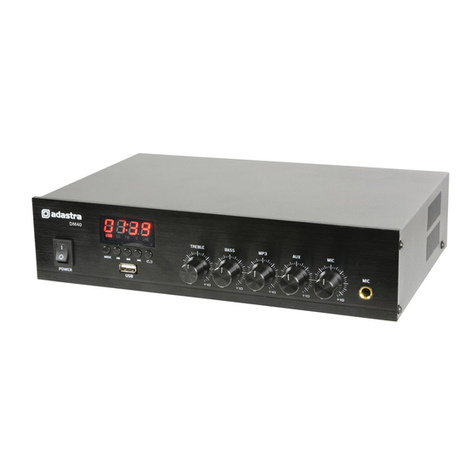
Adastra
Adastra DM40 User manual
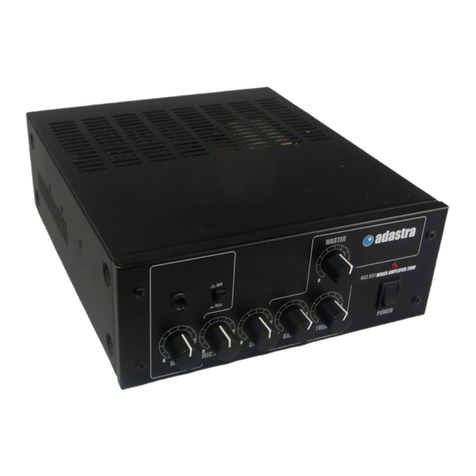
Adastra
Adastra 952.931 User manual
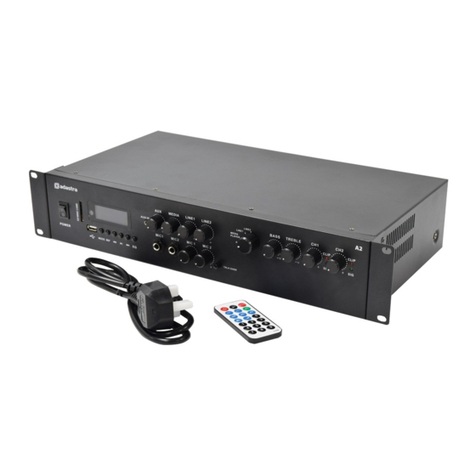
Adastra
Adastra A2 User manual

Adastra
Adastra RM244V User manual
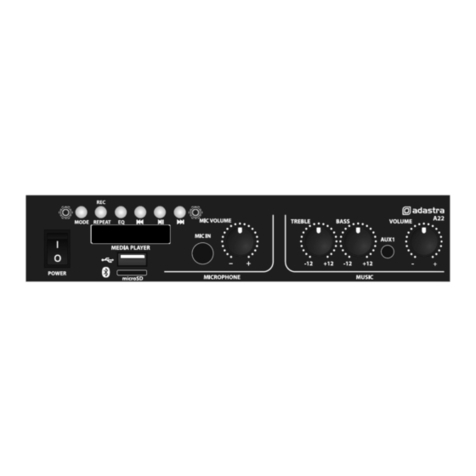
Adastra
Adastra A22 User manual
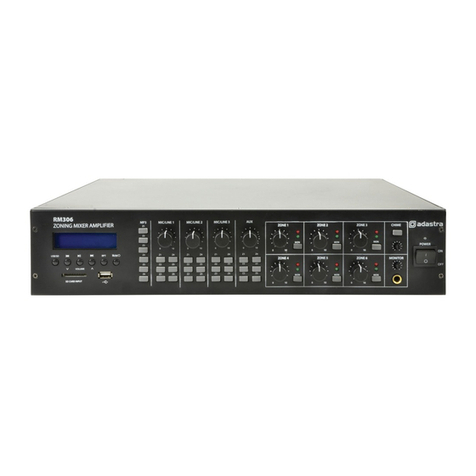
Adastra
Adastra RM306 User manual
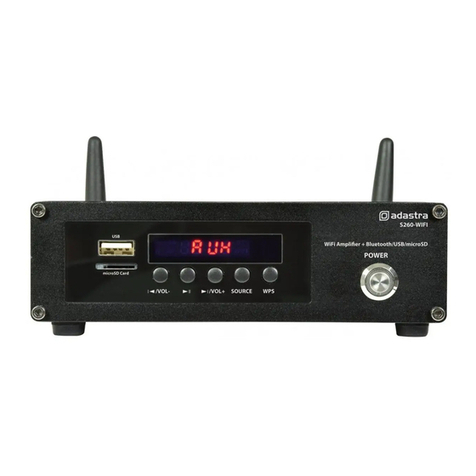
Adastra
Adastra S260-WIFI User manual
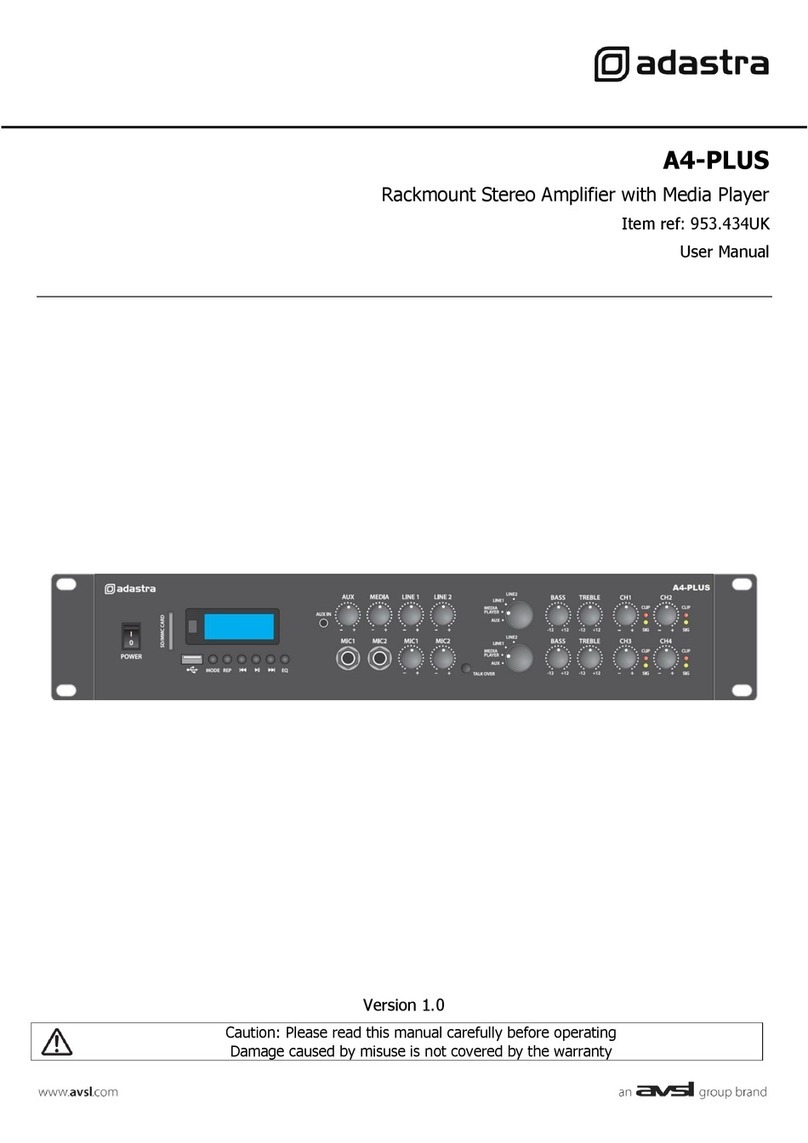
Adastra
Adastra A4-PLUS User manual

Adastra
Adastra 952.916 User manual
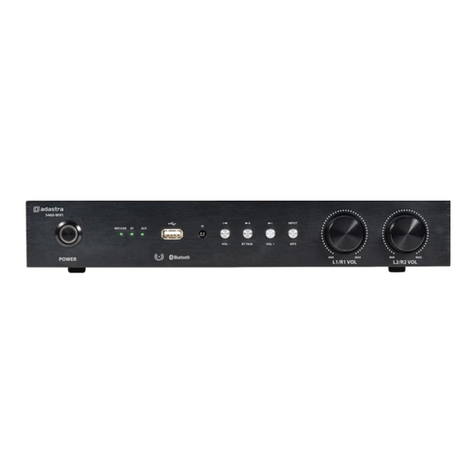
Adastra
Adastra S460-WIFI User manual

Adastra
Adastra A120TUD User manual
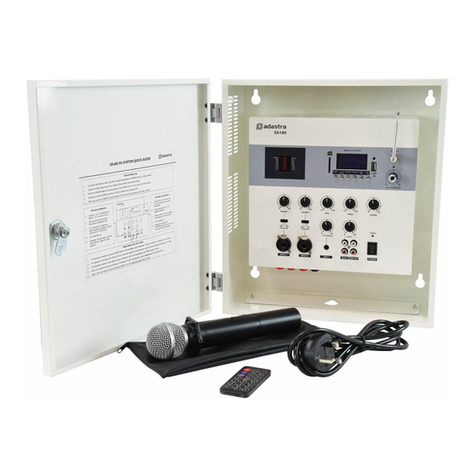
Adastra
Adastra SA180 User manual

Adastra
Adastra A200 User manual
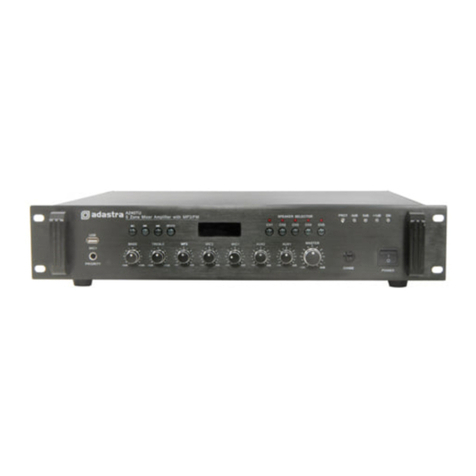
Adastra
Adastra A240TU Instruction manual
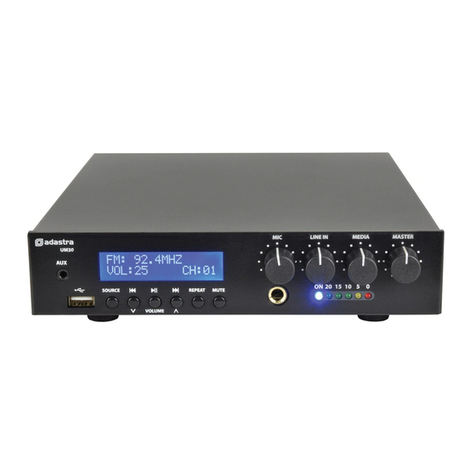
Adastra
Adastra UM60 User manual

Adastra
Adastra 953.122UK User manual

Adastra
Adastra RM60 User manual
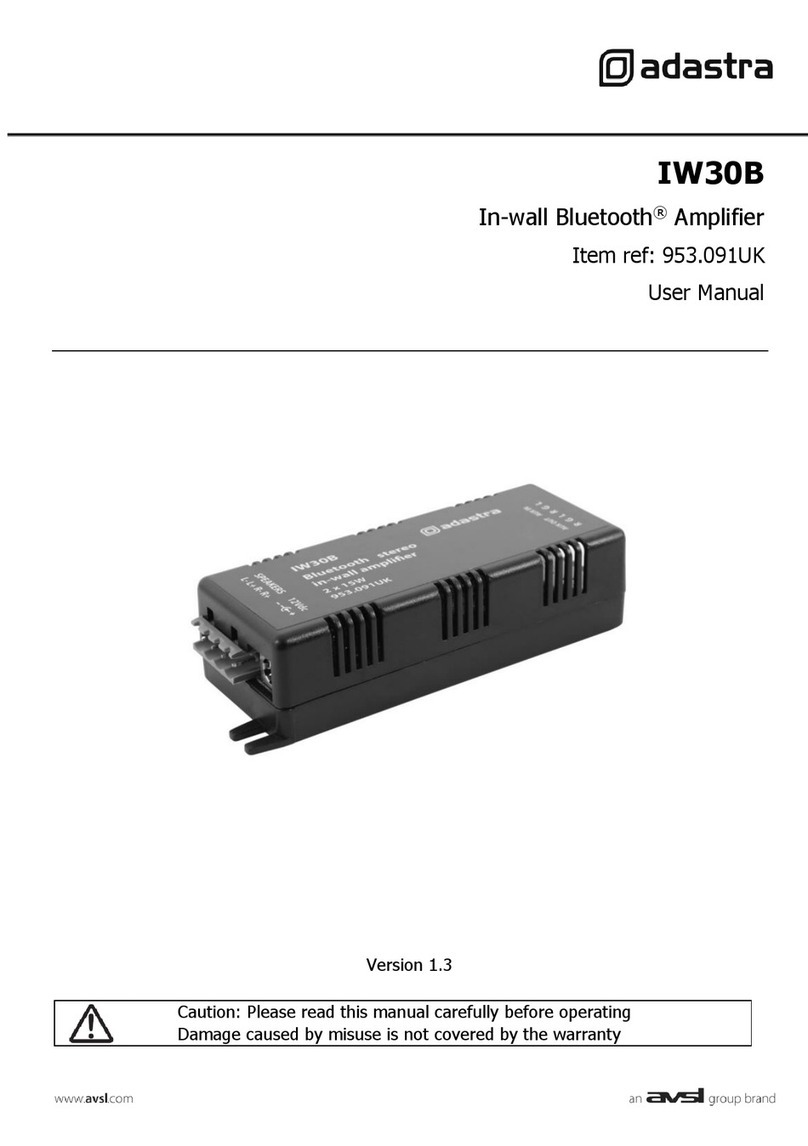
Adastra
Adastra 953.091UK User manual
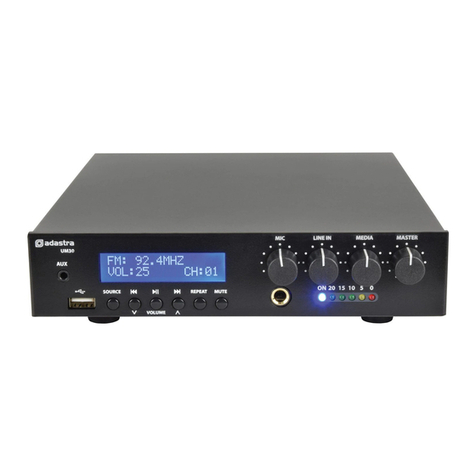
Adastra
Adastra UM Series User manual
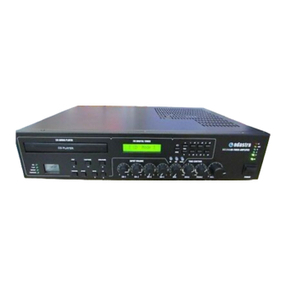
Adastra
Adastra 952.916 User manual

